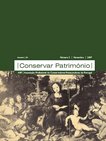 |
António João Cruz, "Em busca da imagem original: Luciano Freire e a teoria e a prática do restauro de pintura em Portugal cerca de 1900", Conservar Património, 5, 2007, pp. 53-83, doi:10.14568/cp5_4 |
|
⯇ | ⯈ |
| Resumo |
A partir de afirmações fragmentárias que se encontram em diversos textos, especialmente num relatório de natureza memoralística escrito na década de 1930, pretende-se reconstituir, tanto quanto possível, a teoria e a prática do restaurador Luciano Freire (1864-1934), que interveio em muitas das "Mais" importantes pinturas dos museus portugueses. De acordo com as suas palavras, essas intervenções justificaram-se sobretudo pelos danos que os restauradores do passado causaram às pinturas, quer através de repintes, as situações "Mais" frequentes, quer através de limpezas, as situações piores, e pelos danos devidos às condições a que as obras foram expostas. Tiveram como objectivo geral a recuperação da imagem original. Em princípio, Luciano Freire era adepto da limpeza completa de sujidades e vernizes e remoção de retoques e repintes, tal como era feito na National Gallery, em Londres, mas na prática admitia que não fossem levantados os retoques e repintes bem realizados e em bom estado. Considerava que as lacunas devem ser integradas e, dividido entre a recuperação da imagem original e o respeito pela obra original, geralmente acabava por considerar que os retoques miméticos só podem ser realizados quando há vestígios suficientes para servirem de guia. Portanto, o retoque tem limites que, no entanto, reconhece, ultrapassou algumas vezes. Embora não tenha usado a radiografia, atribuía grande importância à documentação das suas intervenções, quer através da fotografia, quer através de outros meios. |
| Title |
In search for the original image: Luciano Freire and the theory and practice of painting restoration in Portugal circa 1900 |
| Abstract |
From the fragmentary statements found in several texts, especially from a report written in the 1930's that presents memoir notes, this paper intends to reconstitute, as much as possible, the restoration theory and practice of Luciano Freire (1864-1934). He treated many of the most important paintings belonging to Portuguese museums and, according to his words, those interventions were justified, above all, by the damages caused by past restorers, through repaints, which was frequent, or through cleaning, which originated the worst problems, and by the damages caused by the ambient conditions surrounding the paintings. In general, the interventions aimed at recovering the original image. Although Luciano Freire was, in theory, an adept of the complete cleaning of dirt and varnishes and complete removal of retouches and repaints, as it was done in National Gallery, London, in practice he admitted that when the retouches and repaints were well done and in good condition they were not to be removed. He considered that losses should be reintegrated and his thoughts were divided by the recovering the original image and the respect for the original work. He usually ended up considering that mimetic retouching could only be done when enough clues were present. Therefore, retouching had limits that, however, he recognizes, he crossed at times. Although did not use radiographs, he attributed great importance to treatment documentation through photography or other means. |
| Editora |
URL |
| Ver |
PDF |
| |
Academia | Researchgate |
| Importar |
RIS | Endnote |
